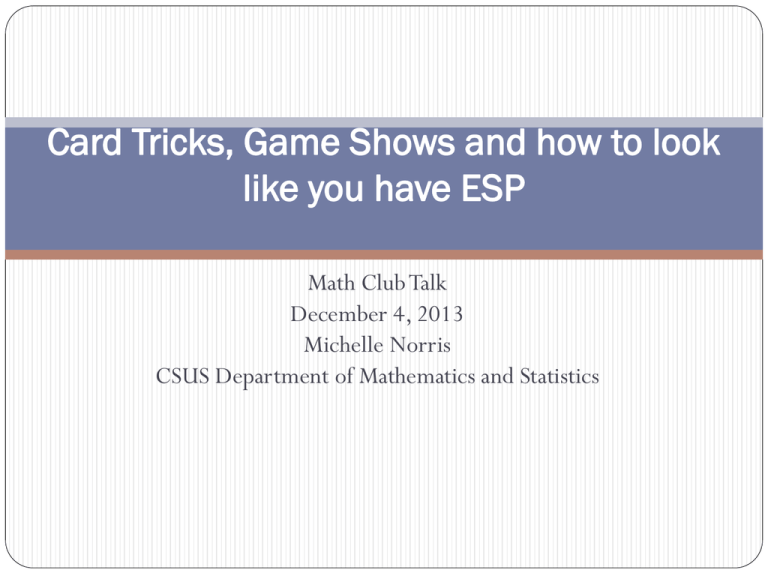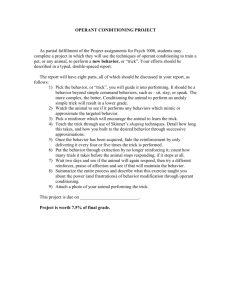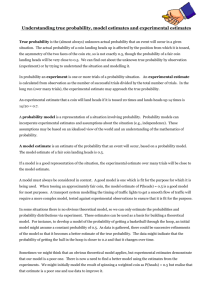Slides from Math Club Talk on Dec 4, 2013
advertisement

Card Tricks, Game Shows and how to look like you have ESP Math Club Talk December 4, 2013 Michelle Norris CSUS Department of Mathematics and Statistics Nothing as mundane as safety should interfere with a tea break Funny opening joke Q: How many mathematicians does it take to screw in a light bulb? A1: None. It's left to the reader as an exercise. A2: None. A mathematician can't screw in a light bulb, but he can easily prove the work can be done. Outline Brainteasers 3-cards trick 5 coins trick Detecting real sequences of coin flips Markov chain sequence trick Monty Hall problem Detecting real sequences of coin flips, Part II Brainteaser 1 Make the fish swim in the opposite direction by moving only 3 matchsticks Brainteaser 2 You have sealed the ninth of nine identical parcels of precisely equal weights, only to discover that your diamond ring has accidentally fallen into one of the packages. You don’t want to unwrap every parcel. Can you work out how to find the parcel containing the ring with just two weighings on a balance scale? Brain Teaser 3 You will be given 12 toothpicks. You need to make corrals to enclose 6 farm animals. Each animal must have its own corral and be fully enclosed. Is this possible? (You aren’t allowed to break the toothpicks and toothpicks must be placed end-to-end.) Card Trick I will demonstrate a card trick Try to figure out why the trick works Try the Card Trick Student 1 picks out 3 cards, writes them down, keeps them With remaining cards, student 2 makes stacks of 14,15,15 and 5 cards from left to right (face down) Student 1 places one card on the stack of 14, cuts the next stack to stack 1 and places the next card on stack 2. Then cuts stack 3 to stack 2 and puts the last card on stack 3 Student 2 stacks rightmost pile on top of 2nd to rightmost pile, and continues this stacking to the left Student 2 divides card – up, down, up, down… Keep dividing “down” pile until there are 3 cards left Why does the card trick work? Give hints. BUY MORE DECKS OF CARDS, TAKE OUT JOKERS Coin trick Toss 5 coins. While the magician is looking away flip as many pairs of coins as you want cover any single coin with your hand I will guess the covered coin Try to figure out why it works You try the coin trick in pairs. Detecting Real sequences of coin flips Split the participants into 4 groups. After I leave the room, 2 groups each make up a “fake” sequence of 100 coin flips 2 groups toss coins to get actual sequence of 100 coin flips Use 0=tails and 1=heads, each group writes their sequence on the board without identifying how it was constructed. Come get me and I will identify which sequences are real and which are fake. Sequence trick Randomly generated order for two shuffled decks of cards: "Q" "K" "5" "6" "2" "K" "7" "5" "J" "2" "J" "7" "Q" "7" "8" "2" "K" "4" "7" "4" "Q" "J" "4" "A" "K" "3" "7" "3" "4" "Q" "9" "10" "6" "6" "3" "10" "7" "5" "5" "10" "2" "5" "8" "8" "2" "3" "9" "J" "A" "3" "5" "4" "A" "2" "3" "A" "9" "K" "J" "Q" "6" "6" "8" "A" "8" "Q" "10" "8" "2" "10" "A" "K" "9" "J" "10" "2" "Q" "J" "J" "8" "8" "5" "7" "A" "6" "7" "4" "4" "A" "9" "9" "10" "K" "K" "4" "10" "Q" "3" "9" "5" "9" "6" "3" "6" Start by choosing a random number,n, between 1 and 6. This is the card you start with in the sequence. Find the nth card and note its value (J,Q,K count as 10 and Aces are 1), move that many cards down the list to get your next card, note the value of this card and move that many cards down the list to get the next card Keep repeating this process until you move off the end of the list, your “score” is the value of the last card before you moved off the list. Remember your score. Why does this trick work? The Monty Hall Problem From the game show Let’s Make a Deal which aired in the 1970’s How to play: http://www.grand-illusions.com/simulator/montysim.htm Is it better to switch doors or stay with the original door chosen? Play the Monte Hall Game We will play the game to see which strategy is better Choose a volunteer to play http://www.grand-illusions.com/simulator/montysim.htm The Monty Hall Game Which strategy seems to work better? What is the probability of winning under each strategy? The Monty Hall Controversy From Wikipedia “It [the Monty Hall Problem] became famous as a question from a reader's letter quoted in Marilyn vos Savant's "Ask Marilyn" column in Parade magazine in 1990 (vos Savant 1990a). Vos Savant's response was that the contestant should switch to the other door. (vos Savant 1990a)” “Many readers of vos Savant's column refused to believe switching is beneficial despite her explanation. After the problem appeared in Parade, approximately 10,000 readers, including nearly 1,000 with PhDs, wrote to the magazine, most of them claiming vos Savant was wrong (Tierney 1991). Even when given explanations, simulations, and formal mathematical proofs, many people still do not accept that switching is the best strategy (vos Savant 1991a). Paul Erdős, one of the most prolific mathematicians in history, remained unconvinced until he was shown a computer simulation confirming the predicted result (Vazsonyi 1999).” Detecting unusual proportions If a fair coin is tossed 25 times, is it unusual to get 72% heads? 0.60 heads? If a fair coin is tossed 100 times, is 65% heads unusual? 55% heads? How about 1000 tosses? What range do we expect the percent of heads to be in? Detecting unusual sample proportions COMPUTERIZED DRAWING GLITCH STRIKES ARIZONA LOTTERY Aug. 20, 2013, http://www.lotterypost.com/news/265143 Pick 3 is an Arizona Lottery draw game in which players pick three numbers and can win a prize up to $500. Tickets cost $1 each and drawings are held every day, Monday through Saturday. On Aug. 5, the Arizona Lottery discovered there was an issue in the Pick 3 programming code that prevented the numbers eight and nine from being drawn in certain positions between June 10 and Aug. 3. For one lottery number, what is the probability of not getting an 8 or 9 in the first position? Suppose there were 49 draws, is it very likely to never get an 8 or a 9 in the first position? Approximately, what percent of the time should the first number generated be an 8 or a 9? Thanks to the Math Club for inviting me to speak!






